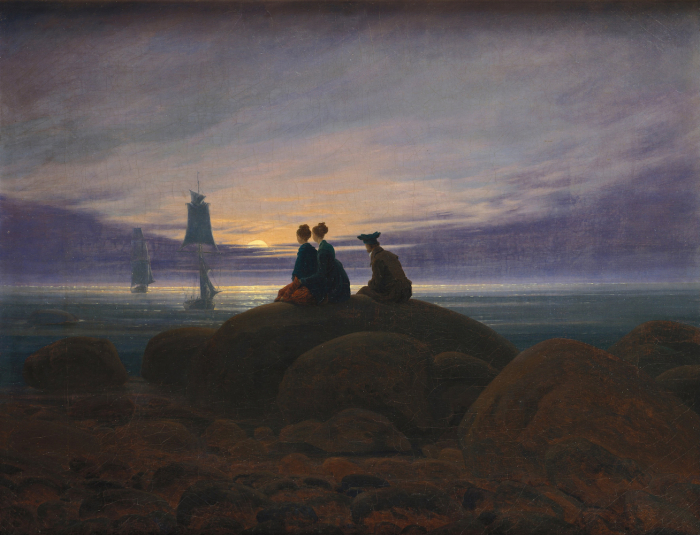Moonrise Over the Sea
Caspar David Friedrich
550x710 mm
Oil paint
A faraway sea and a remote period bring us a story that is both true and mythical.
On the 19th May 1845 both the Erebus and the Terror, commanded by Sir John Franklin, set out from England questing for the Northwest Passage. Months and months went by but no news came of the two ships. England held its breath and fruitless rescue expeditions followed one another for years. Objects coming from the ship were found in the land of the Inuit, on the ice pack of King William Island somebody had left marks to find the ships, and at the same time, in America, the Fox sisters affirmed that they were spiritually connected to the survivors.
Research continued throughout the nineteenth century.
The fate of the survivors was guessed at in magazines and pubs: the unbelievable cold, isolation. The never-ending darkness on ice.
More than one century afterwards, the corpses of some members of the crew were exhumed. They had struggled to survive for almost two years, then died of pneumonia, tuberculosis, scurvy and lead poisoning due to canned food, which was poorly preserved itself.
Among the remains, signs of cannibalism were also found that revealed a tragedy within the tragedy, the epilogue of a story of unfortunate heroes.
But, in spite of its outcome, Franklin’s expedition has become legendary, the subject of artworks, statues, songs, poems, tales, novels and documentaries1.
It belongs to us.
Let’s move on to the painting2: those who wait. The gaze lost in a calm and moving sea, at the moonrise. Among them are probably the relatives of one of the sailors, with the greatest hope and the greatest tragedy in their hearts, merging in the wait that corrodes the soul, day after day.
One of the women could be the wife of Franklin.
Or maybe his partner or his mother, the daughter of one of the many people who left their houses, two centuries ago as well as today, lost in Our Sea, whose fate remains a mystery. There are no interpreters in the harbour master’s offices, and only few witnesses can provide information about missing people.
It is easier to write about the horrors of the Erebus or the Terror than of the journey of many migrants, for whom crossing the sea is only the last of many torments.
Their story is up to that of our Captains Courageous, and their families at home wait for them with the same trepidation that spurred a nation for more than one century.
The only difference lies in the fact that we are not interested in the migrants’ stories because they don’t belong to us – or so we think, often because it’s other people who tell us about them in their personal dark stories.
The simplicity of Friedrich’s painting tells us about people and about another sea, cruel and enormous, the calm (and implacable) background of the stories of those who wait on the shore for somebody to come back.
1 | The episode is mentioned (among others) by captain Nemo in Twenty Thousand Leagues Under the Sea by J. Verne and in the novel by Dan Simmons, The Terror.
2 | C. D. Friedrich, Moonrise over the sea, oil on canvas, 1822, Alte Nationalgalerie, Berlin.

